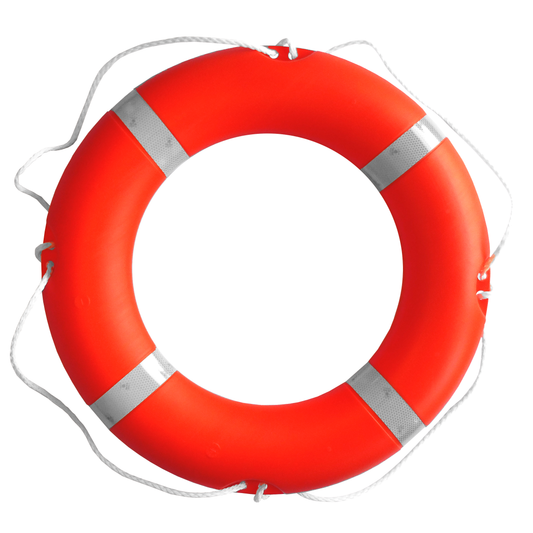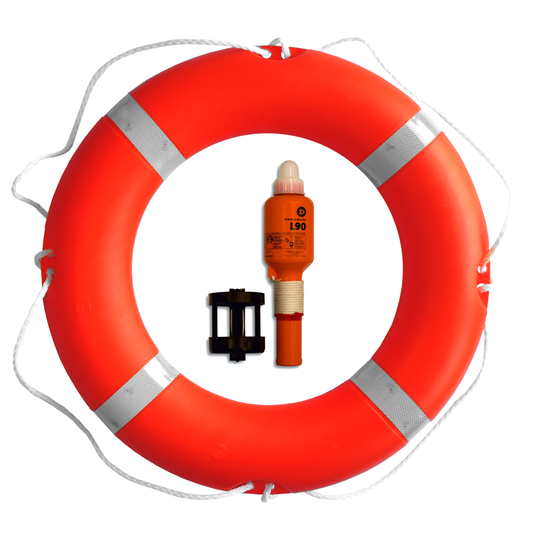SOLAS Lifebuoys
-
 Sold out
Sold outOrange SOLAS Lifebuoy 30" (75 cm)
Regular price €59,99 EURRegular priceUnit price / per -
 Sold out
Sold outOrange SOLAS MOB Lifebuoy
Regular price €79,99 EURRegular priceUnit price / per -
 Sold out
Sold outOrange SOLAS MOB Lifebuoy
Regular price €84,99 EURRegular priceUnit price / per -
 Sold out
Sold outOrange SOLAS Lifebuoy 24" (60 cm)
Regular price €79,99 EURRegular priceUnit price / per -
 Sold out
Sold outLifebuoy with Line
Regular price €69,99 EURRegular priceUnit price / per -
 Sold out
Sold outLifebuoy with Holder
Regular price €154,99 EURRegular priceUnit price / per -
 Sold out
Sold outLifebuoy with Light
Regular price €114,99 EURRegular priceUnit price / per -
Life Ring / Lifebuoy with Line and Light
Regular price €129,99 EURRegular priceUnit price / per -
 Sold out
Sold outLifebuoy with Holder and Line
Regular price €169,99 EURRegular priceUnit price / per -
 Sold out
Sold outSOLAS Lifebuoy with Holder and Light
Regular price €214,99 EURRegular priceUnit price / per
Buy Lifebuoys with SOLAS approval in Orange
-
SOLAS approved Lifebuoys
The SOLAS lifebuoy in orange is the international standard lifebuoy. The approved lifebuoy fulfils the globally applicable safety requirements for lifebuoys in accordance with the SOLAS Code. Our SOLAS lifebuoys in orange impress with their equally high-quality and robust workmanship.
The SOLAS regulations have their origins in a famous event: the sinking of the Titanic in 1912. At the time of the disaster, the regulations for life-saving appliances and rescue equipment, as well as for many other safety-related aspects of shipping, were not standardised worldwide and in some cases were only very vague. The regulations for lifebuoys on board also changed with the international regulations. The new lifebuoy standard is set out in MED - EN14144 - SOLAS 74. The SOLAS 74/96 regulation for lifebuoys ensures that the same safety standard is always guaranteed on board ships and boats, especially on the high seas.
The SOLAS lifebuoy with throwing line and light is an ideal combination when it comes to rescuing drowning persons. You can of course buy a high-quality lifebuoy throwing line and a corresponding rescue light from us together with your new SOLAS-approved lifebuoy. A lifebuoy with light and a lifebuoy with line are available as a discounted package. The night light is attached next to the lifebuoy. The floating line is connected to the lifebuoy and also attached next to it. If a dangerous situation arises, the lifebuoy with line ensures that the lifebuoy and the drowning person do not drift away. The lifebuoy with light means that their position can always be recognised, even in the dark. The lifebuoy light is often also referred to as a rescue signalling buoy or night light.
-
Standard Lifebuoys
The SOLAS lifebuoy is now also established as a lifebuoy for construction sites and industry. Many customers from industry and the construction sector therefore rely on the high quality of our SOLAS-approved lifebuoys.
An approved SOLAS lifebuoy, usually weighing 2.5 kg, is designed as a rescue device for classic first aid for drowning victims. The SOLAS MOB lifebuoy with a weight of 4 kg or 4.5 kg is suitable for the man-overboard manoeuvre and is generally used in conjunction with a smoke and light signal. A SOLAS lifebuoy usually has a hard plastic shell, which is particularly robust, durable and weather-resistant. A SOLAS lifebuoy with the ship's name and home port is prescribed by the international regulations for seagoing vessels. You can buy a SOLAS lifebuoy in our online shop. If you wish, we can also personalise it with your name, boat name, ship name and home port.
A lifebuoy with approval and certification has established itself as the absolute No. 1 and standard lifebuoy due to its durability, size and good visibility. The SOLAS-certified lifebuoy is not only a reliable lifesaver, but also a real maritime eye-catcher. Not least because of this, the orange lifebuoy is now very popular even in pleasure craft and water sports and is also used on boats and yachts. You can buy the SOLAS lifebuoy from us in proven brand quality.
The entire MOB manoeuvre, all necessary rescue measures and rescue equipment are precisely prescribed in the SOLAS Convention. You can also buy an orange SOLAS MOB lifebuoy in our online shop.
The lifebuoy with throwing line and holder is the usual use of the SOLAS lifebuoy in 75 cm. The lifebuoy, the throwing line and the holder are of extremely high quality. You can always buy your lifebuoy with throwing line and holder from us free of charge.
-
Lifebuoys in Orange
The approved SOLAS lifebuoy in orange is the standard lifebuoy in shipping, regardless of whether it is a seagoing vessel or an inland waterway vessel. A SOLAS approved lifebuoy has the necessary technical features prescribed by the International Convention for Safety at Sea. These requirements relate to the size of the lifebuoy's outer diameter and inner diameter, as well as its weight and maximum jettison height. In addition, the SOLAS regulations stipulate that a lifebuoy used in maritime shipping must have reflective stripes and be in the signal colour orange. The SOLAS agreement also regulates how many lifebuoys must be present on a ship. A SOLAS-approved orange lifebuoy fulfils all the required points.
If a man-overboard situation arises, one thing counts above all: speed. It is also essential to have the right rescue equipment to hand and to be able to use it in a targeted manner. In the classic MOB manoeuvre, it is a major challenge not to lose sight of the drowning person. When the water temperature is below 20° C, there is a particular risk of hypothermia. Due to the high requirements for SOLAS approval, the SOLAS-certified lifebuoy is no longer only found on seagoing vessels and inland waterway vessels. In fact, the SOLAS-certified lifebuoy has become the standard lifebuoy in harbours, on beaches, in outdoor swimming pools and on the banks of rivers and lakes.
If a person has gone overboard, man overboard must be called immediately, indicating on which side of the ship the person has gone overboard. At least one crew member who has remained on board must watch the person at all times and point to them with an outstretched arm. On a boat, the MOB manoeuvre involves immediately turning around and returning to the drowning person. The scene of the accident must be marked immediately with a special MOB lifebuoy. This is particularly heavy and complies with the special SOLAS rules.
SOLAS lifebuoy: requirements at a glance
The SOLAS (Safety of Life at Sea) regulations define the international standards for ensuring the safety of people on board ships. The official name of the agreement is ‘International Convention for the Safety of Life at Sea, 1974’ or ‘International Convention for the Safety of Life at Sea, 1974’.
The SOLAS Convention stipulates various requirements for lifebuoys in shipping. These are summarised as follows:
- The inner diameter of the lifebuoy should not be less than 400 mm and the outer diameter should not exceed 800 mm.
- The weight of the lifebuoy should not be less than 2.5 kg.
- The weight of the man-overboard lifebuoy (MOB) should not exceed 4 kg.
- The diameter of the grab line should not be less than 9.5 mm.
- The length should be at least 4 times the outer diameter of the lifebuoy and secured at four points equidistant from each other.
- The lifebuoy should be capable of supporting at least 14.5 kg of iron in fresh water for 24 hours.
- The lifebuoy should be made of buoyant material.
- The lifebuoy should not continue to burn or melt after it has been completely enveloped in fire for two seconds.
- The lifebuoy should be capable of withstanding a drop from a height at which it is stowed above the waterline in the lightest seas or from 30 metres, whichever is greater, without losing its integrity.
- At least one lifebuoy on each side of the vessel must be equipped with a buoyant lifeline.
- The length of the lifeline should not be less than twice the height at which it is stowed above water in the lightest seas or 30 metres, whichever is greater.
- At least half of all lifebuoys on board must be fitted with a self-igniting light.
- At least two lifebuoys must be fitted with an automatic smoke signal.
- At least one lifebuoy should be located near the stern.
- The lifebuoys should be distributed on board in such a way that they are easily accessible on both sides of the ship for all open decks.
- Lifebuoys should be stowed in such a way that they can be thrown away quickly and are not permanently secured.
- Each lifebuoy must be labelled with the name and home port of the ship in capital letters of the Latin alphabet.
- The number of lifebuoys required depends on the length of the vessel as follows:
- Cargo ships:
- Ship length less than 100 metres: 8 lifebuoys
- Ship length greater than 100 metres: 10 lifebuoys
- Vessel length greater than 150 metres: 12 lifebuoys
- Vessel length greater than 200 metres: 14 lifebuoys
- Passenger ships:
- Ship length less than 60 metres: 8 lifebuoys
- Vessel length of more than 60 metres but less than 120 metres: 12 lifebuoys
- Vessel length greater than 120 metres but less than 180 metres: 18 lifebuoys
- Vessel length of more than 180 metres but less than 240 metres: 24 lifebuoys
- Ship length greater than 240 metres: 30 lifebuoys










